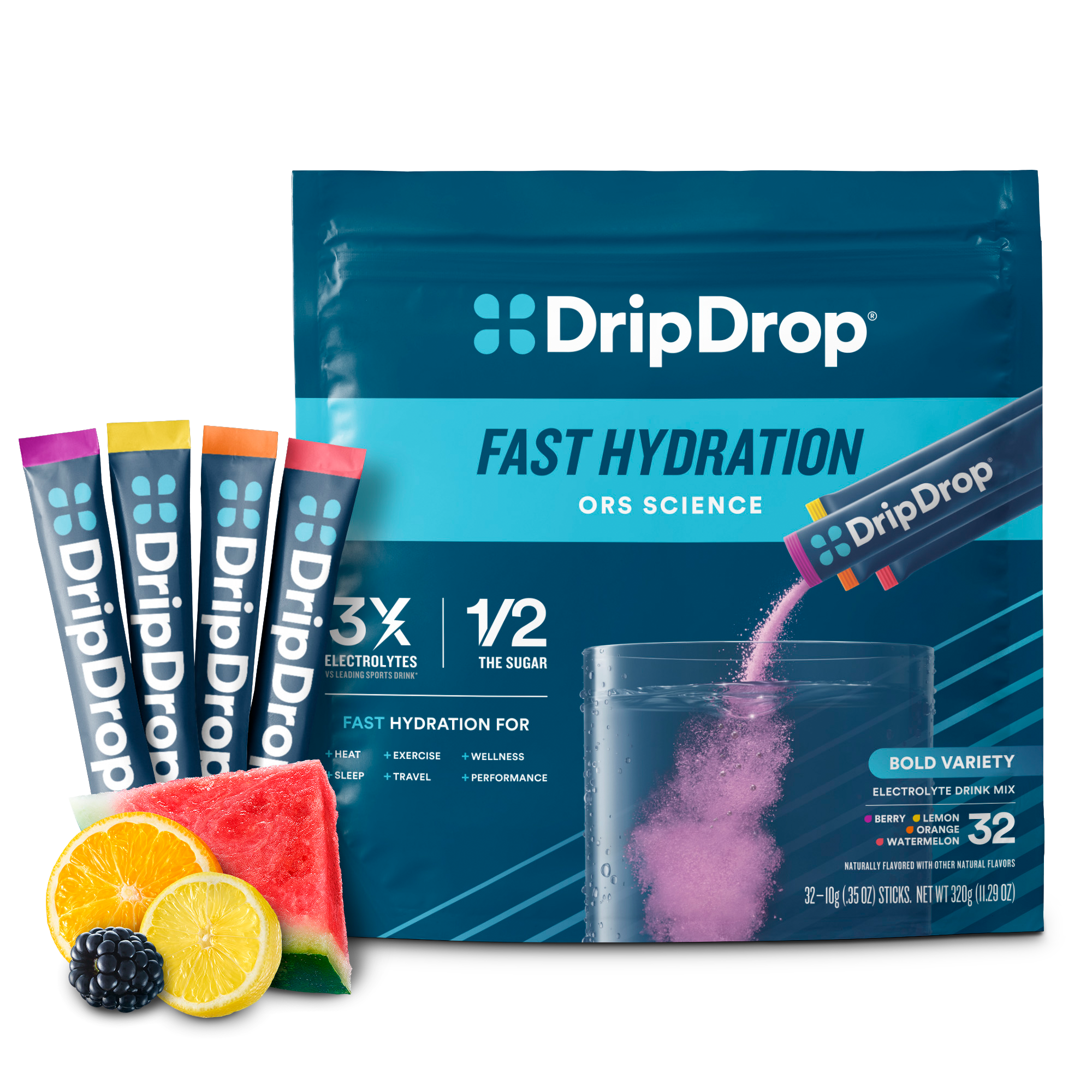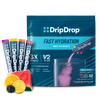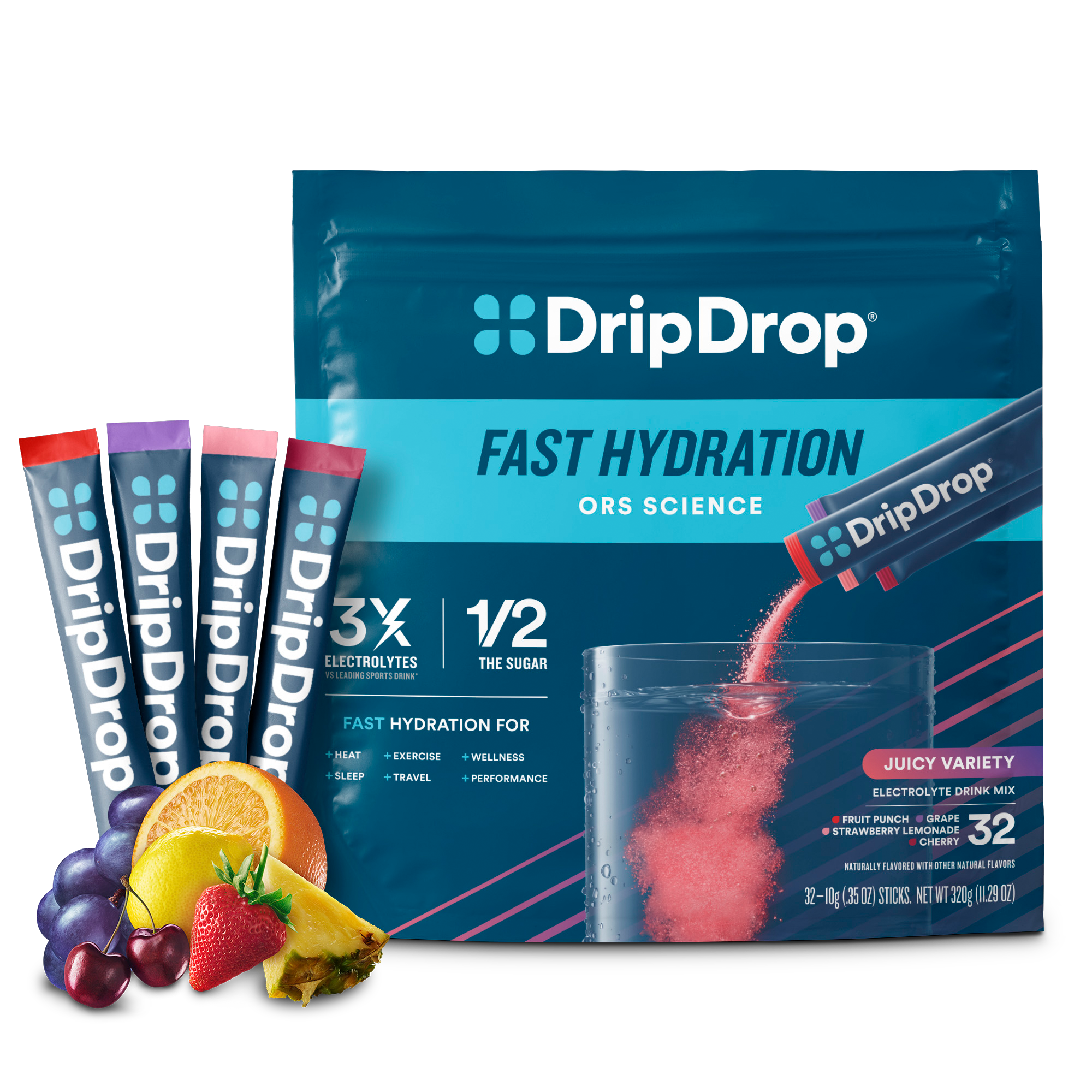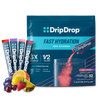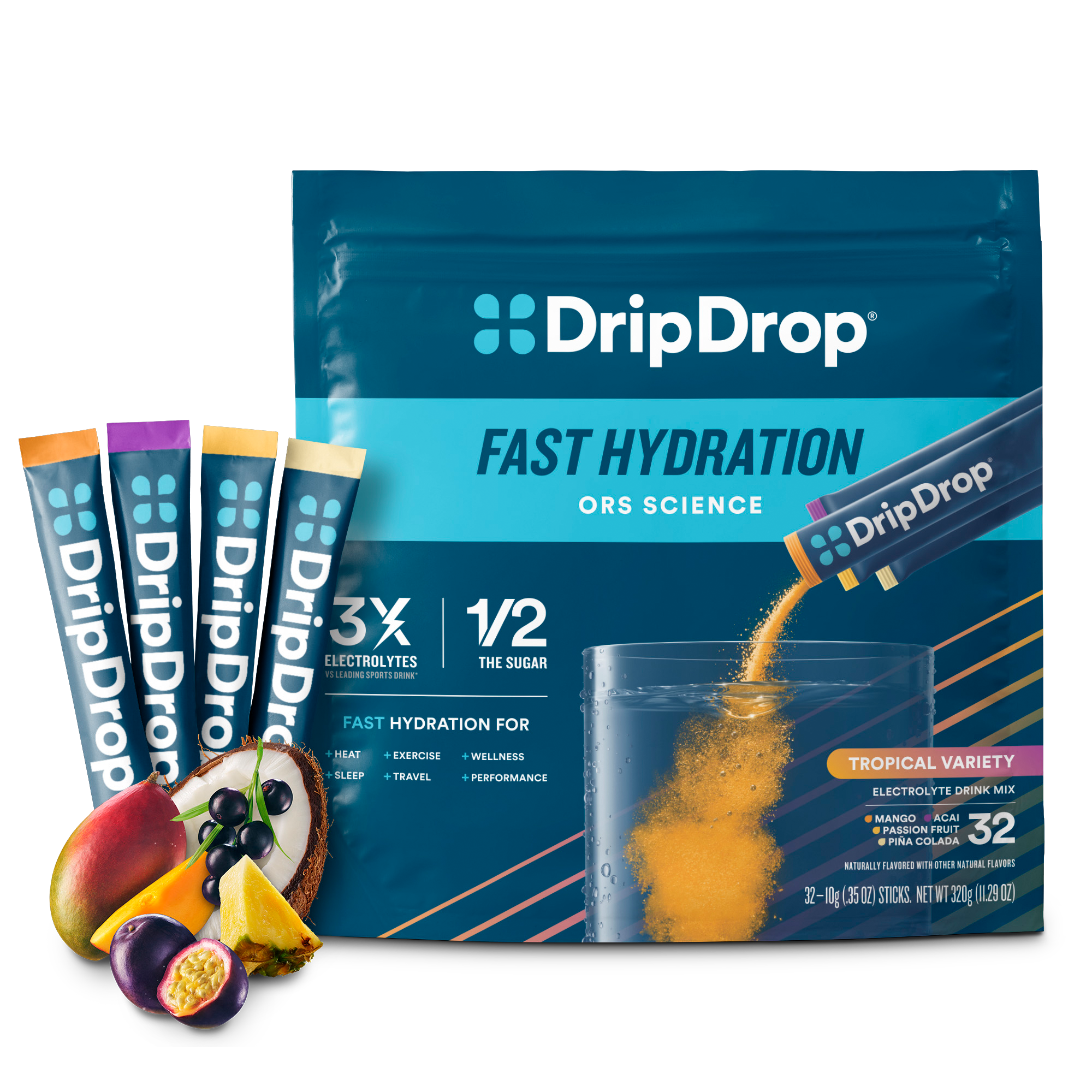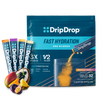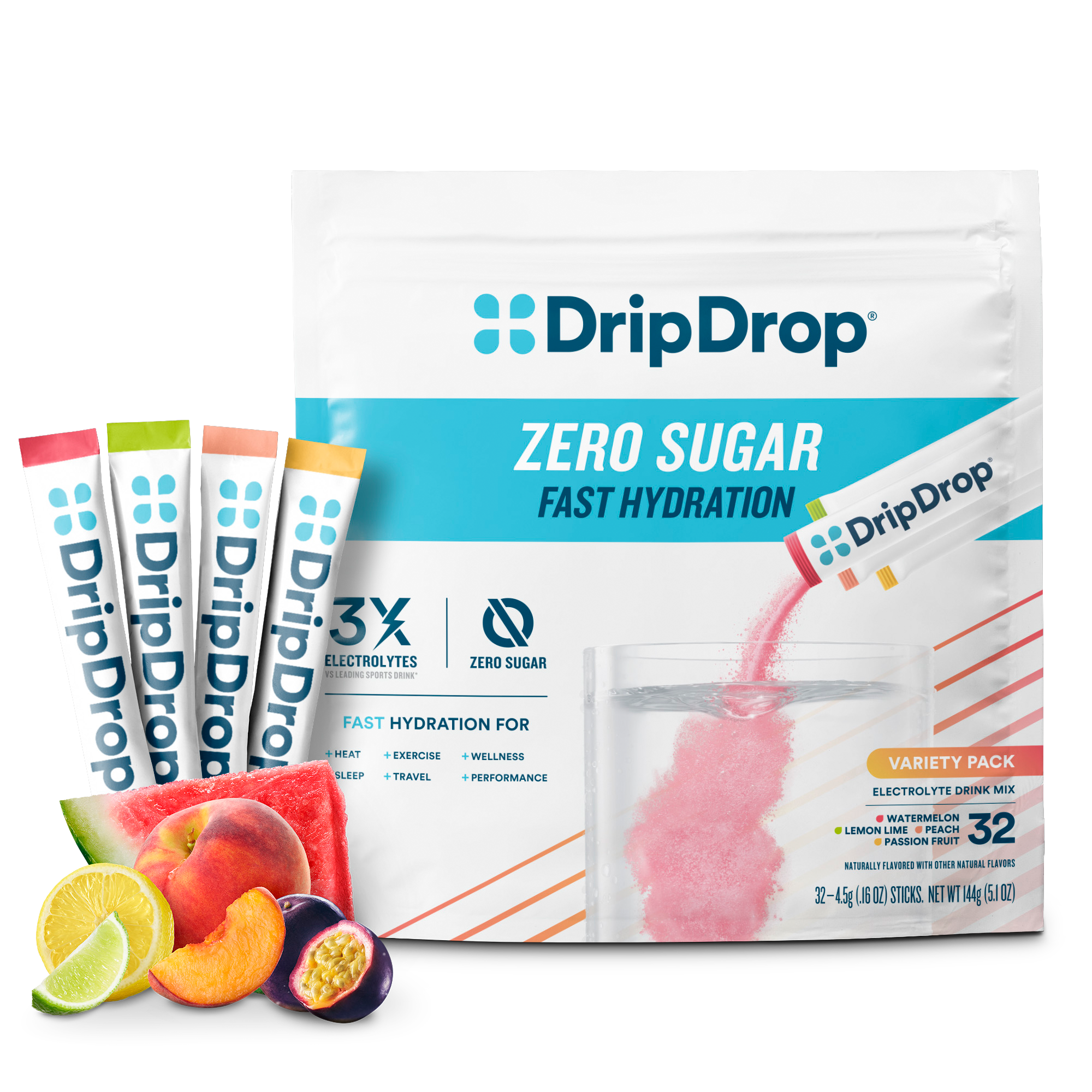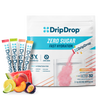We all know that food and water are essential to human survival. If you don’t get enough, you may experience negative health effects. One of these is dehydration, which occurs when your body loses more water and electrolytes than it’s getting. Signs of dehydration include extreme thirst, decreased urine output, muscle cramps, confusion, and headaches. In severe cases, dehydration may require medical treatment and intravenous therapy.
However, there are less invasive ways to tackle mild to moderate dehydration, helping you avoid unwanted and costly hospital stays. IV therapy alone costs at least a couple of hundred dollars but often far more money. Here, we’ll show you everything you need to know about IV fluids for dehydration, including its pros and cons. You’ll find proven alternatives, including oral rehydration solutions like DripDrop that are low-cost, pain-free, and fast remedies for mild to moderate dehydration.
Basics of Dehydration
Dehydration is caused by several factors, including excessive sweating, not drinking enough fluids, and illnesses like gastroenteritis that cause diarrhea and vomiting — which in turn lead to rapid fluid and electrolyte loss. Certain medical conditions such as kidney or renal disease and medications like diuretics can also increase the risk of dehydration.
Everyone is at risk of dehydration, though older adults and young children tend to experience higher rates of severe cases that require hospitalization. While mild cases of dehydration can cause headaches, lightheadedness and fatigue, and low blood pressure, other signs develop when the condition becomes more severe.
Here are some severe signs of dehydration that may require medical attention:
- Sunken soft spot (for infant dehydration)
- Few or no wet diapers for three hours or more (for dehydrated children)
- Sunken eyes
- Rapid breathing or rapid heart rate
- Fainting
Once you understand the signs of dehydration, you can choose a plan of action. Quick, fast relief is essential to avoid severe cases of dehydration. As soon as you experience signs of dehydration, sip on an oral rehydration solution like DripDrop. It contains medically relevant electrolytes to help you crush dehydration fast.
Read on to learn more about how IV fluids for dehydration are administered, and learn why an oral rehydration solution like DripDrop can be an effective alternative in mild to moderate cases.
How IV Therapy Works
Moderate to severe dehydration is often treated at the hospital or doctor’s office using intravenous therapy. The IV mixture is usually a saline solution that may also contain glucose or dextrose and electrolytes such as potassium.
The solution includes sodium because it’s a vital electrolyte that helps to restore hydration fast. In addition, sugars work to decrease osmolality — the pressure required for electrolytes to enter cell membranes — enabling your body to absorb electrolytes like sodium more quickly. The exact mixture of your IV will depend on whether you have any electrolyte deficiencies such as low sodium levels that can cause dehydration and the severity of your condition.
IV fluids are made using crystalloid solutions, which enable water to move in or out of your cells thanks to a process called osmosis. In cases of malnutrition, colloids — large molecules that draw fluids into intracellular spaces — are used instead of crystalloids since they require lower volumes of water.
There are three types of crystalloids:
- Hypotonic: The most common type of hypotonic IV fluid is called half-normal saline — which contains 0.45% sodium chloride and 5% glucose . This type is often used to treat dehydration from hypernatremia, metabolic acidosis, and diabetic ketoacidosis. Hypotonic IV fluids contain fewer solutes (substances that dissolve in another substance) compared to blood plasma. That means these solutions cause fluid to shift from extracellular fluid — located outside your cells — to intracellular fluid (fluid found inside cell membranes).
- Hypertonic: These IV fluids contain large amounts of solutes (375 meq/L and greater), causing fluids to move out of cells and into intravascular spaces such as your bloodstream. They are usually made of 3% or 5% sodium chloride and are used to treat hyponatremia — a condition where your body doesn’t have enough sodium.
- Isotonic: This is the most common type of IV fluid. Isotonic IV fluids include normal saline, 5% dextrose solutions dissolved in water, and Lactated Ringer's solutions. These are used for dehydration caused by electrolyte imbalances as well as fluid loss from diarrhea and vomiting. The fluids contain an electrolyte content of around 310 meq/L and the same solutes as blood concentration. This means that this type of IV fluid will bulk up both the fluid inside and outside of your cells equally.
For IV therapy, a medical professional injects IV fluid into you or your child’s veins using a small needle. The needle is attached to a tube which leads to a bag containing the normal saline solution or another hydrating fluid. The tubing also has an adjustable valve that allows the doctor or nurse to control the amount of fluid you receive.
Next, we’ll cover the pros and cons of IV fluids for dehydration. You’ll discover why IV therapy is a quick remedy for moderate to severe dehydration and why an oral rehydration solution like DripDrop is a fast, low-cost, proven alternative to IV therapy when it comes to alleviating mild to moderate dehydration.
Pros and Cons of IV Fluids for Dehydration
Healthcare practitioners use IV fluids for dehydration, as they are an effective way to promote fluid replacement. They work rapidly and, since they’re formulated to meet any electrolyte deficiencies, they provide exactly what your body needs to manage dehydration. With different formulations, IV fluids can address fluid deficits, fluid balance, and electrolyte composition to target the underlying cause of dehydration.
There are also some drawbacks to Intravenous fluid therapy. IV fluids for dehydration are typically given as an inpatient procedure. That means to get IV therapy, you’ll likely have to complete tons of paperwork and stay in the hospital or pediatric care center for hours. You won’t be released until a doctor or nurse clears you for discharge.
In addition, intravenous rehydration can be painful. People who are afraid of needles may especially have a hard time with IV therapy. The needle also has to stay in your arm throughout the process, which may cause discomfort.
If the dehydration is severe and IV therapy is required for an extended period of time, the vein may collapse. Vein collapse typically occurs with repeated or long-term treatment using needles. It is more common in children and isn’t life-threatening. It does, however, mean the nurse will have to re-inject the needle into another vein.
If you move around a lot during the IV treatment, you can also dislodge the needle, causing a condition known as infiltration. This occurs when the needle moves and injects fluids into areas outside of your veins. It can cause bruising and stinging sensations. To remedy the condition, the nurse or doctor will have to re-insert the needle into the vein.
Proven Alternatives To IV Therapy for Dehydration
Oral rehydration therapy is a proven alternative to painful IV therapy. This therapy involves drinking an oral rehydration solution like DripDrop and is recommended by organizations like the WHO and UNICEF for mild to moderate cases of dehydration.
Medical-grade DripDrop allows you to handle mild to moderate dehydration outside of a hospital setting, without the need for costly and painful IV therapy. Our patented formula is powerful enough to help patients suffering from dehydration caused by Ebola and cholera, but safe enough for everyday use. Plus, DripDrop tastes amazing and comes in a variety of flavors you can enjoy hot or cold.
Here’s some background on DripDrop. DripDrop was developed by a doctor on a mission to defeat life-threatening dehydration. The patented formula provides medically relevant electrolyte levels, improving on the World Health Organization’s Oral Rehydration Solution (ORS) standards because of its delicious taste, giving you a medically viable that also tastes great. Sports drinks, on the other hand, contain about one-half the electrolytes of DripDrop and twice as much sugar.
Manage Mild To Moderate Dehydration With DripDrop
When you're in a state of dehydration, water alone is not enough. Your body needs the perfect balance of sodium and glucose to help absorption. For cases of severe dehydration, hospitalization and IV therapy may be required. That doesn’t mean you have to check yourself into a hospital or resign yourself to painful IV fluids for dehydration relief if you have mild to moderate dehydration.
For cases of mild to moderate dehydration, DripDrop is a fast, effective, and great tasting remedy. With the precisely balanced ratio of electrolytes, you can replenish vital electrolytes and fluids to relieve dehydration quickly. Plus, DripDrop supplies vitamins like zinc, potassium, and magnesium, which are essential to support your overall health. Its convenient packaging allows you to have DripDrop when you need it, where you need it.
Get started with our most popular multi-flavor pouch for dehydration relief fast. Or, learn more about how you can save up to 25% on every purchase when you subscribe.



